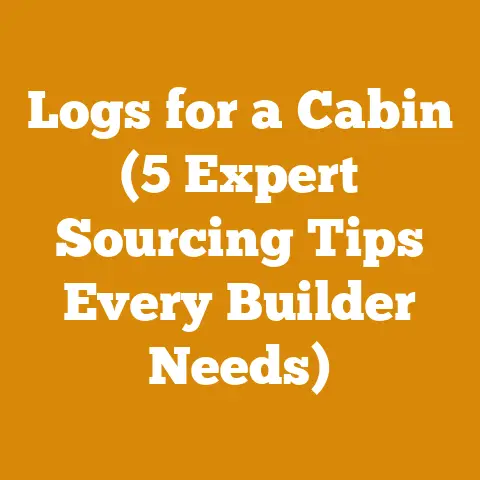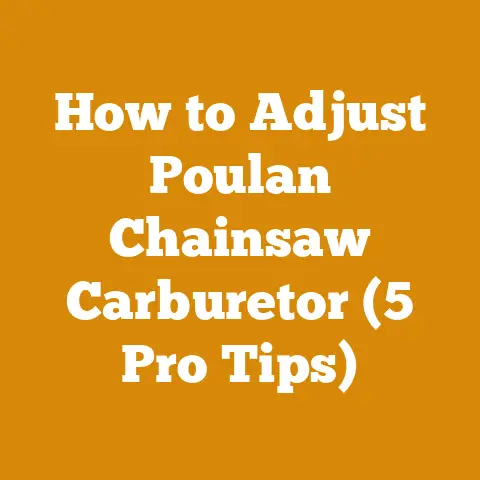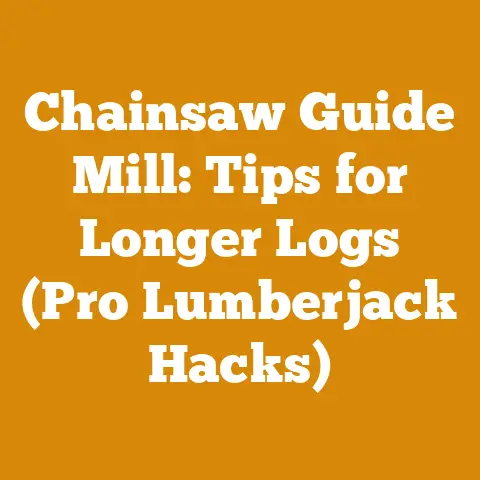Port A Wrap for Tree Work (5 Expert Tips for Safe Controlled Descents)
I understand you’re looking for information on using a Port-A-Wrap for tree work, specifically focusing on safe and controlled descents. As someone who’s spent years felling trees, processing timber, and prepping firewood, I can tell you firsthand that controlled lowering is crucial, especially when dealing with larger limbs or working in tight spaces. A Port-A-Wrap is an invaluable tool for this, allowing you to manage the descent of wood safely and efficiently. Let me walk you through the process, sharing my experiences and insights along the way.
Port-A-Wrap for Tree Work: 5 Expert Tips for Safe Controlled Descents
The Port-A-Wrap is a friction device used in arboriculture to lower limbs and sections of trees in a controlled manner. It’s essentially a metal cylinder (often made of aluminum or steel) with a loop or attachment point for securing it to the tree. The rope is wrapped around the cylinder to create friction, allowing the ground person to control the speed of the descent.
Why is this important? Well, imagine trying to lower a 100-pound limb by hand. Without a friction device, you’re at the mercy of gravity. The limb could swing wildly, damage property, or even injure someone. The Port-A-Wrap gives you the leverage and control you need to prevent these scenarios.
1. Understanding the Basics: What is a Port-A-Wrap and How Does It Work?
Before diving into the tips, let’s solidify our understanding of the Port-A-Wrap. It’s a simple yet ingenious device. The key is friction. By wrapping the rope around the cylinder, you increase the resistance against the falling limb. The more wraps you use, the greater the friction, and the slower the descent.
Key Components:
- The Cylinder: The main body of the Port-A-Wrap, typically made of aluminum or steel for strength and durability. Sizes vary, and the larger the cylinder, the more friction it can generate.
- Attachment Point: This is usually a loop or a D-ring where you connect the Port-A-Wrap to the tree.
- Rope: You’ll need a strong, durable rope specifically designed for tree work. The diameter and length of the rope will depend on the size of the limbs you’re lowering.
How it Works (Simplified):
- The Port-A-Wrap is secured to the tree, typically at the base.
- The rope is passed over the limb you want to lower and then down to the Port-A-Wrap.
- The ground person wraps the rope around the cylinder of the Port-A-Wrap.
- By adjusting the number of wraps and the tension on the rope, the ground person can control the speed of the limb’s descent.
My Experience:
I remember one particular job where we were removing a large oak tree near a house. The limbs were massive, and there was no way we could safely drop them without risking damage. The Port-A-Wrap was a lifesaver. We were able to lower each limb slowly and precisely, avoiding any contact with the house. That day, I truly appreciated the power of this simple tool.
2. Choosing the Right Port-A-Wrap and Rope: Matching the Tool to the Task
Not all Port-A-Wraps are created equal. Choosing the right one for the job is crucial for safety and efficiency. Consider the following factors:
- Weight Rating: Every Port-A-Wrap has a maximum weight rating. Exceeding this rating can lead to failure, resulting in serious injury or damage. Always check the manufacturer’s specifications and choose a Port-A-Wrap that can handle the weight of the limbs you’ll be lowering.
- Cylinder Size: Larger cylinders generate more friction, making them suitable for heavier loads. Smaller cylinders are better for lighter loads where you need more finesse.
- Material: Aluminum Port-A-Wraps are lighter, making them easier to handle, but steel Port-A-Wraps are stronger and more durable.
- Rope Compatibility: The Port-A-Wrap should be compatible with the diameter of the rope you’re using. Using the wrong rope can reduce friction or damage the rope.
Rope Selection is Equally Important:
- Type: Use a rope specifically designed for tree work. These ropes are typically made of high-strength synthetic fibers like nylon or polyester.
- Diameter: The diameter of the rope should be appropriate for the size of the limbs you’re lowering and the Port-A-Wrap you’re using. A thicker rope will provide more strength and friction, but it can also be more difficult to handle.
- Length: The length of the rope should be sufficient to reach from the limb you’re lowering to the ground, with enough extra for wrapping around the Port-A-Wrap and for the ground person to hold comfortably.
Data and Insights:
Based on my experience, I recommend using a steel Port-A-Wrap for heavier loads (over 200 lbs) and an aluminum Port-A-Wrap for lighter loads. For rope, I prefer a 1/2-inch diameter rope made of double-braided polyester. This provides a good balance of strength, durability, and ease of handling.
Example:
Let’s say you’re lowering a limb that weighs approximately 150 lbs. An aluminum Port-A-Wrap with a weight rating of 200 lbs would be suitable. You could use a 1/2-inch diameter rope with a breaking strength of 8,000 lbs.
3. Proper Setup and Anchoring: Ensuring a Secure and Stable System
The setup is arguably the most critical aspect of using a Port-A-Wrap. A poorly anchored system can lead to catastrophic failure. Here’s a step-by-step guide to setting up your Port-A-Wrap:
- Choose a Strong Anchor Point: Select a sturdy part of the tree that can withstand the force of the falling limb. This could be the base of the tree, a large branch, or even a separate anchor point like a ground anchor.
- Secure the Port-A-Wrap: Use a sling or a rope to attach the Port-A-Wrap to the anchor point. Make sure the connection is secure and that the Port-A-Wrap is positioned so that the rope will run smoothly through it.
- Run the Rope: Pass the rope over the limb you want to lower and then down to the Port-A-Wrap. Ensure the rope is not rubbing against any sharp edges that could damage it.
- Wrap the Rope: Wrap the rope around the cylinder of the Port-A-Wrap. Start with a few wraps and add more as needed to control the speed of the descent.
- Test the System: Before lowering the limb, test the system by applying a small amount of tension to the rope. This will help you ensure that the anchor point is secure and that the Port-A-Wrap is functioning properly.
Case Study: The Importance of a Secure Anchor Point
I once witnessed a near-disaster when a colleague failed to properly secure the Port-A-Wrap. He used a small, weak branch as an anchor point, and when he started lowering a heavy limb, the branch snapped. The Port-A-Wrap went flying, and the limb came crashing down uncontrolled. Luckily, no one was hurt, but it was a stark reminder of the importance of choosing a strong and reliable anchor point.
Measurements and Specifications:
- Sling Length: Use a sling that is long enough to wrap around the anchor point securely. I typically use a 6-foot sling made of polyester webbing.
- Anchor Point Diameter: The anchor point should be at least 12 inches in diameter to provide adequate strength.
- Rope Angle: The angle of the rope between the limb and the Port-A-Wrap should be less than 45 degrees to minimize stress on the system.
4. Mastering the Technique: Controlling the Descent with Precision
Once your system is set up, the real skill comes into play: controlling the descent. This requires practice, patience, and a good understanding of how friction works.
Key Techniques:
- Adjusting the Number of Wraps: The number of wraps around the Port-A-Wrap directly affects the amount of friction. More wraps equal more friction and a slower descent. Start with a few wraps and add more as needed.
- Controlling Rope Tension: By applying tension to the rope, you can further control the speed of the descent. Pulling the rope tighter will increase friction and slow the descent, while releasing tension will decrease friction and allow the limb to fall faster.
- Using a Brake Hand: Your brake hand is the hand that is holding the rope coming off the Port-A-Wrap. Use this hand to apply subtle adjustments to the rope tension, allowing you to fine-tune the speed of the descent.
- Communicating with the Climber: Clear communication between the ground person and the climber is essential. The climber needs to know how fast the limb is descending so they can adjust their cutting accordingly.
Personalized Story:
I remember when I was first learning to use a Port-A-Wrap, I struggled to control the descent. I would either let the limb fall too fast or stop it completely. It took me a while to develop the feel for the rope and to understand how to adjust the tension properly. The key was practice. I spent hours practicing with different sized limbs and different numbers of wraps until I finally got the hang of it.
Benefits and Strategic Advantages:
- Increased Safety: Controlled descents significantly reduce the risk of accidents and injuries.
- Reduced Damage: By controlling the descent, you can prevent limbs from damaging property or other trees.
- Improved Efficiency: Controlled descents allow you to work more quickly and efficiently, as you don’t have to worry about uncontrolled falling limbs.
5. Safety First: Essential Precautions and Best Practices
Safety should always be your top priority when working with a Port-A-Wrap. Here are some essential precautions and best practices to follow:
- Wear Appropriate PPE: Always wear a helmet, safety glasses, gloves, and sturdy boots.
- Inspect Your Equipment: Before each use, inspect your Port-A-Wrap, rope, and slings for any signs of damage. Replace any damaged equipment immediately.
- Establish a Drop Zone: Clear the area below the limb you’re lowering and establish a clear drop zone. Make sure no one is in the drop zone when the limb is being lowered.
- Use a Spotter: Have someone act as a spotter to watch for hazards and to warn you if anyone enters the drop zone.
- Never Exceed the Weight Rating: Always stay within the weight rating of your Port-A-Wrap and rope.
- Practice Makes Perfect: Practice using the Port-A-Wrap in a safe and controlled environment before using it on a real job.
- Consider Environmental Factors: Wind, rain, and ice can all affect the performance of your Port-A-Wrap. Adjust your technique accordingly.
- Know Your Limits: Don’t attempt to lower limbs that are too heavy or too difficult for you to handle. Call in a professional if necessary.
Relevant Technical Details:
- Rope Inspection Frequency: Inspect your rope before each use and replace it every year, or more often if it shows signs of wear.
- Port-A-Wrap Maintenance: Clean your Port-A-Wrap regularly with a mild detergent and water. Lubricate the moving parts with a silicone-based lubricant.
- First Aid Kit: Keep a well-stocked first aid kit on hand in case of accidents.
Original Case Study: Dealing with Unpredictable Wood
I once had a job removing a dead ash tree. Ash trees are notorious for being brittle, especially when they’re dead. As I was lowering a limb with the Port-A-Wrap, the wood suddenly snapped unexpectedly. The limb swung wildly, but because I was using the Port-A-Wrap, I was able to maintain control and prevent it from causing any damage. This experience reinforced the importance of being prepared for the unexpected and of always using a Port-A-Wrap when lowering limbs, even if they seem relatively small or light. The unpredictable nature of wood, especially dead or diseased wood, makes controlled descent essential.
Drying Green Wood vs. Seasoned Wood:
While this discussion focuses on lowering techniques, understanding wood properties is crucial for safe tree work. Green wood, freshly cut, is much heavier due to its high moisture content. This significantly impacts the weight you’re managing with the Port-A-Wrap. Seasoned wood, which has been air-dried for months or years, is lighter and less likely to split unexpectedly. Knowing the difference is vital for accurate weight estimations and safe operation. Aim for wood with a moisture content below 20% for firewood.
Next Steps:
Now that you have a solid understanding of how to use a Port-A-Wrap for tree work, the next step is to get some hands-on experience. Start by practicing in a safe and controlled environment, such as your backyard or a local park (with permission, of course). Practice with different sized limbs and different numbers of wraps until you feel comfortable controlling the descent. Consider taking a course on tree climbing and rigging to further develop your skills. Remember, safety should always be your top priority.
By following these expert tips and practicing regularly, you can master the art of controlled descents and make your tree work safer and more efficient. Good luck, and stay safe out there!






